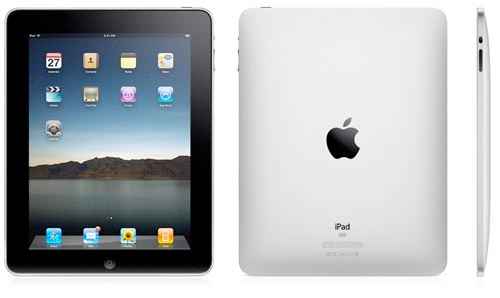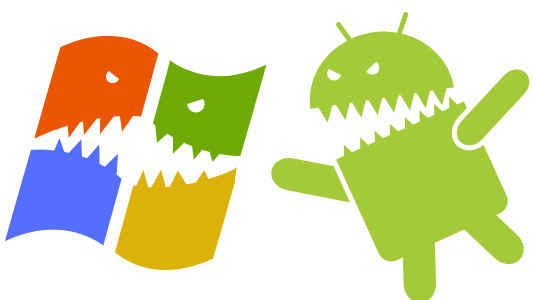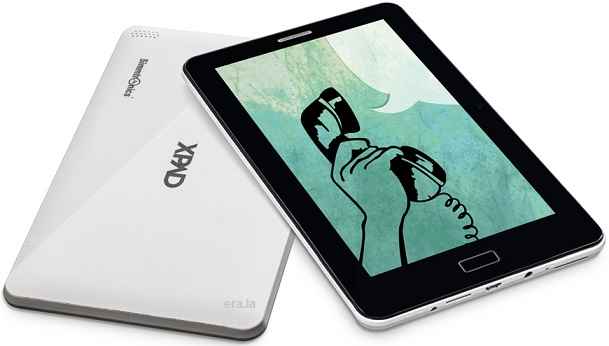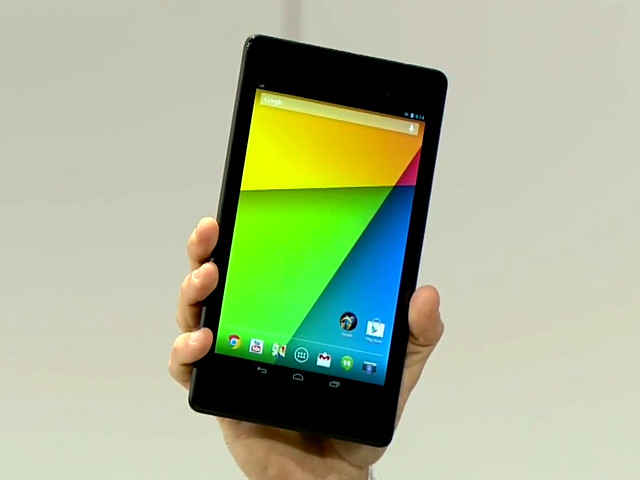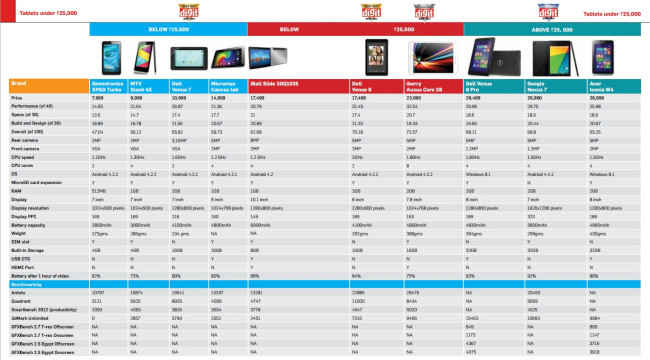Top 10 affordable Quad-Core tablets compared
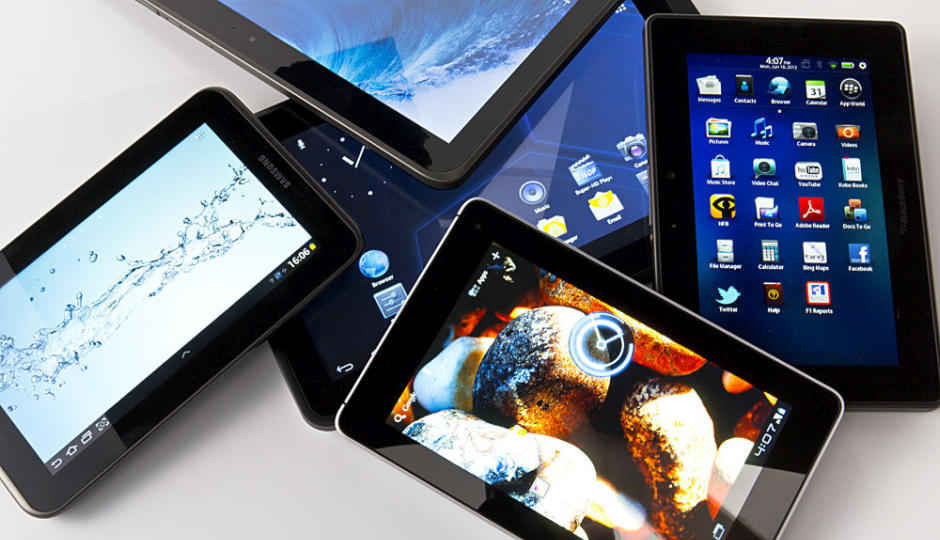
We test ten affordable quad-core tablets from reputed brands and a few from new kids on the block to see which one makes the cut for your best needs.
The defining benchmark of a Post PC era is that tablets are becoming hugely popular and are giving a stiff competition to laptops and ultrabooks. And why not? They are much more portable and offer almost all the features and capabilities one can get on a laptop. Most modern-day tablets are easily as powerful (if not more) as two-three year old laptops.
The ‘slate’ has been prevalent for quite a few years but the modern age tablet gained popularity and traction in the year 2010. In our opinion, the credit goes to Apple for shaping the tablet market when it released the first iPad in 2010 and pushed tablet segment into the mainstream consumer market. The company also brought in capacitive touchscreens to the tablet category which meant that users could just tap away with their fingers without having to rely on a stylus pen. A number of manufacturers followed Apple’s move and today every hardware-based technology company operating in the consumer space has a tablet to offer.
The tablet that started it all: iPad
According to the International Data Corp. (IDC) the year 2013 saw a rise of 50.6% in tablet sales with the worldwide tablet shipments totalling to 217.1 million, an increase from 144.2 million in 2012. For the Indian market, researchers have predicted that the period of 2013- 2014 will see a boost of 50% in the sales on tablets. These numbers are actually huge and are a big threat for laptop makers as the tablet has been marginalizing PCs and laptops for quite some time.
A large chunk of the total number of tablets in the market is occupied by Android as it has become the dominating platform in the mobile device industry purely by number of devices adopting it. Apart from Android one can even get their hands on a Windows 8.1 running tablet under a budget of `25,000 which provides the Modern UI, as well as proper desktop mode just like a PC. Today, manufacturers like Apple and Samsung offer tablets in a premium range but a large portion of consumers in the Indian market opt for more affordable tablets to fit their budgets.
While we are on the subject, the budget category of tablets has widened a lot and with Indian brands bringing in a mix of their own products, there has been an increase in variety as well. If we look back to 2013, getting your hands on a powerful tablet meant shelling out a lot of money. But times have changed and one can easily get a tablet running on a quad-core processor with plenty of features under a budget of Rs 20,000 without breaking a sweat.
For this shootout we have picked tablets from well-known companies and also some indigenous brands which provide some competitive features. The focus here is on tablets selling around `25,000 which attracts the majority of the consumers. We have included eight Android tablets namely the Dell Venue 7 and Venue 8, iBerry Auxus CoreX8, iBall Slide 3G Q1035, Micromax Canvas Tab, Google Nexus 7 (2013), MTV Slash 4X and Simmtronics XPad Turbo. We have also included two Windows 8.1 tablets one from Dell and one from Acer.
THE PLATFORMS
Android had stepped into the tablet game by releasing a different version altogether (3.0 Honeycomb) which was specifically designed for tablets. It did not gain a lot of popularity back then, so Google scrapped it off and made a unified version (4.0 Ice Cream Sandwich) that would run both on smartphones and tablets. Today the platform is on the verge of becoming the most selling tablet operating system and the numbers are just going stronger by the day. Almost all of the Android tablets that we have tested run on Android 4.2 and the only tablet with the latest KitKat update was the Nexus 7.
Hopefully manufacturers will be announcing some new tablet this year with Google’s latest 4.4.2 update. With almost 2 million apps available on the Google Play store, Android tablets are poised to take over the industry. When Microsoft had announced that Windows 8 will feature an app ecosystem on top of the traditional desktop layout, it seemed logical that the OS would be ported to tablet devices. The good part is that one can get a full-fledged desktop/laptop experience but the bad part is that using its touchscreen on the desktop mode is a real pain. The tiled UI is similar to what we have seen on Windows Phone devices and the apps work in a similar fashion. With the app development steadily going stronger, Windows 8.1 tablets could soon gain a decent market share.
PERFORMANCE
Tablets today offer a blazing performance and manufacturers have to cram in some high-end hardware to achieve that. Apart from hardware, an optimized OS is very crucial. Now it doesn’t make sense buying a tablet with a good set of specs but a sluggish interface, does it?
The Acer Iconia W4 runs on an Intel Bay Trail processor with four cores which means that the tablet can perform functions as smoothly as one can do on a laptop. Since the tablet runs Windows, you can install proper softwares like PC games as well as apps from the Windows App store. The tablet didn’t disappoint us at any time as it managed to run HD videos, open multiple apps and softwares, and was pretty smooth in the gaming department as well. We also ran a couple of benchmarks on the Iconia W4and found the scores to be pretty decent. Even in the battery test we found that the tablet can continuously play full HD videos for about 7 hours, which is quite good for a tablet in our experience.
Acer Iconia W4
But to be honest, it was a pain to use the touchscreen in the desktop mode as it requires very precise tapping. Using a mouse via Bluetooth made the experience much better, but that just kills the purpose of having a tablet in the first place. The only logical competitor to the Acer tablet is the Dell Venue 8 Pro.
While this also is Windows 8.1 tablet, the Venue Pro 8 seemed slightly faster in terms of performance. In the benchmark and the battery tests, the Venue Pro 8 proved to be better than the Acer Iconia W4 simply because it runs on a faster processor with more RAM and has a larger battery. In the benchmark tests the Venue Pro 8 achieved higher scores thanks to its faster processor.
Dell Venue 8 Pro
The Nexus 7 (2013) is said to be the king of Android tablets and in our opinion it is justified to give the title to this tablet. Running on a 1.5GHz quadcore processor with 2GB of RAM, combine that with the latest Android 4.4.2 KitKat OS and you have a super smooth and powerful tablet. Be it gaming, watching videos or just browsing the web, the Nexus 7 does it all with ease and class. In the benchmark scores the Nexus 7 fell short by just a few numbers, but on a daily basis the tablet is actually much faster and responsive. It is also worth mentioning that the 5MP camera on the Nexus 7 was way better than almost every tablet in the shootout.
Among all the Android tablets that we tested in the shootout, the Nexus gave the most battery backup off a single charge cycle. The test proved that the Nexus, even with the full HD resolution, can play a full HD video non-stop for 12 hours. Pretty fantastic! The Android running tablets from Dell, the Venue 7 and Venue 8 seem identical but there is a slight difference. While the Venue 7 runs on a 1.6GHz dual- ore processor, the Venue 8 runs on 2GHz dualcore processor. This makes a huge difference as the Venue 8 performed much better in the benchmark tests. Although we didn’t notice a huge difference when we ran some games and performed daily tasks like email, web browsing and social networking. The Venue 7 was actually quite impressive because the tests concluded that it is almost as powerful as the Nexus 7 and available at less than half the price which makes it a great value for money. Both of the Venue tablets come with a similar 4100mAh battery, but the Venue 8, even with the larger display offered a slightly longer battery backup.
Dell Venue 7 running Android 4.2.2 Jelly Bean
In our opinion Auxus Core X8 by iBerry offers the most impressive hardware, including an Exynos octa-core processor with 2GB of RAM. And yes the hardware does deliver as it aced the benchmark tests in almost every performance department. Gaming and watching HD videos was a sheer pleasure as the tablet managed to provide a very fluid performance. The Android UI however was a slight disappointment as it wasn’t entirely perfect as on random occasions the tablet lagged a bit, for no apparent reason. Overall the tablet delivers a surprisingly fast performance even though it comes from an underrated brand, which is good to see.
The Micromax Canvas Tab is just a stretched out Canvas Doodle 2. This tablet has a similar looking UI as most of Micromax smartphones which is mostly stock Android with a bit of extra apps and customized icons. In our benchmark testing, the tablet gave an average performance although it manages to multitask quite well and apps run quite smooth. Graphically heavy games like Real Racing 3 and Dead Trigger 2 showed signs of lag but games like Temple Run 2 and Angry Birds Star Wars did not give us any issues. In the battery tests we calculated that the Canvas Tab can go on for five hours of constant video playback. The tablet also offers calling capabilities which is pretty decent, although using the device as a phone is a bit uncomfortable.
In the performance test the iBall Slide 3G Q1035 got a very average score. The tablet is powered by a 1.2GHz quad-core processor and to power up the large 10.1-inch 720p display there is a chunky 6000mAh battery. The UI did seem to stutter a bit although apps and games ran perfectly fine and we didn’t notice any major issues. Multitasking and multimedia content was very smooth and the tablet managed to play almost every video format with ease. Gaming experience was decent as graphic hungry games like Asphalt 8 and Dead Trigger 2 were smooth. In the battery test we found that you can play a full HD video non-stop for 8 hours after a full charge to 100%.
iBall Slide 3G Q1035
The lowest powered tablet was the Simmtronics Xpad Turbo which comes with a dual-core processor with a mere 512MB of RAM. Running on Android 4.2.2 the tablet was quite sluggish and at times had a slow response time. It has voicecalling facility and one can also use a SIM to gain 3G data connectivity. Basic apps and day to day productivity seemed decent, but watching full HD videos and playing games with high-end graphics takes a toll on the hardware.
Simmtronics XPAD Turbo
The MTV Slash 4X is a quadcore tablet which is priced at almost the same as the Simmtronics Xpad Turbo, however it is much more responsive and smoother in terms of performance. Its performance on the Slash 4X was comparatively decent for a sub- 10,000 tablet although we wish that the manufacturer had ironed out some of the minor lags it experiences. The tablet didn’t manage to run high-end games smoothly and even crashed on a few occasions. Games like Temple Run 2 and Angry Birds seemed to work just about fine. HD video playback and other multimedia content didn’t show any issues and everything was smooth. There is calling facility on the tablet and it works perfectly fine with clear audio quality.
BUILD AND DESIGN
A high quality design and an attractive look has become a crucial factor for gadgets these days. A very general rule implies here, higher the price better the quality. Tablets have gone much slimmer and much more portable than what they used to be a couple of years back and with such high competition, manufacturers have been producing tablets with a premium finish at an affordable price.
In the build and design test, we have rated each tablet based a number of things like the quality of material, placement of keys, the responsiveness of the display, portability and also the aesthetics of the tablet. The iBerry Auxus Core X8 proved to the most powerful tablet in our performance test and to be honest it has a fairly good looking design. It does resemble a lot to the design philosophy that Samsung uses with its tablets and smartphones with a curvy design and glossy plastic finish. It has a 7.8 inch display and offers more of a 4:3 ratio. The home key is a proper hardware key which is a bit low on quality as it wiggles about. The settings and back key are capacitive placed on either sides of the home key. The tablet offers a proprietary charging port and can be charged via the standard microUSB port as well. The back is all glossy plastic and houses the 5MP camera.
iBerry Auxus Core X8
The Windows 8.1 running Acer Iconia W4 has a very standard tablet design which can fool you very easily as it offers a brushed metal finish, but the tablet is actually made of plastic. It weighs about 430 grams which makes it feel a little heavy although it seems pretty compact due to its 10mm thickness. The 8 inch display offers a resolution of 1280×800 pixels. The screen is bright and vibrant and offers good viewing angles too. Overall Acer as has done a good job with the Iconia W4 however we must confess that 8 inch displays seem too small when using the desktop mode. Both of the Dell Venue tablets have an exactly similar design and even the placement of the volume and power/lock keys, is similar. The back has nice rubberized finish which brings a really nice grip to the tablets. The only difference in the looks department is the size as the Venue 7 is smaller than the Venue 8.
Apart from the screen size, one cannot tell these two apart. The overall finish of the tablets is exceptionally good and loved the display, even though it isn’t full HD. The Dell Venue 8 Pro Window tablet shares its design with its Android siblings and has the exact form factor as the Venue 8. The only difference is that the Venue 8 Pro has a different texture at the back. Apart from the screen size issue on Windows tablets we addressed earlier, we weren’t happy with the placement of the Windows start key. One has to reach all the way for the edge; which is less than ideal.
One of our favourite tablets was the Google Nexus 7 (2013) and although it isn’t one of the flashiest looking tablets, it is the most practical. The 7 inch IPS panel is crisp and has a full HD resolution which means it has the highest ppi among all the tablets that we tested. The design is pretty slim and makes it easy to carry in the back pocket of your jeans. The 2013 version is a great update from last year’s Nexus 7 as it is way more sleek and faster. The Nexus 7 was the slimmest tablet with a thickness of just 8.7mm.
Google Nexus (2013)
The Micromax Canvas Tab looks a lot like a stretched out version of the Canvas Doodle 2. It has a nice strong back which gives off a metal finish, but isn’t entirely made out of metal. Although we did love the quality of its external casing. The 8-inch display has a 1024×768 pixel resolution giving it 160ppi pixel density. Content on the display lack details and the display itself is reflective. The viewing angles are good but we wish the resolution was better. The Canvas Tab is the second tablet in the shootout which offers a display with a 4:3 ratio. The ratio is not a problem when browsing the web or playing games, but when you watch HD videos, there is a waste of real estate as we know HD videos have a widescreen aspect ratio.
Micromax Canvas Tab
The rear houses a camera without a flash and the speaker. The top has the headphones jack, microUSB port and the power button. The right of the tablet houses the volume rocker and a flap below which rests the microSD card slot and the SIM card slot. The biggest tablet that we tested in the shootout was the iBall Slide 3G Q1035, boasting a 10.1 inch display with a 720p resolution. The tablet has a plastic back with a brushed metal finish and due to its big size it is quite bulky and heavy. The overall finish is quite decent but somehow seems a bit clunky. One of the corners has the power/lock key and the volume control keys and also a back key to make operations easy on the large sized tablet. The tablet is equipped with stereo speakers and an 8MP camera with an LED flash. While the 8MP resolution camera sounds good for a tablet, it didn’t seem to impress us all that much as the pictures produced didn’t have sharp details and were high on noise. There is also an HDMI out port which enables you to connect the tablet to a larger display.
The MTV Slash 4X which is one of the most affordable tablets in the shootout offers dual-SIM capability along with a 7-inch display. The design is compact although the quality of plastic used doesn’t have the best of quality. There is a 2MP camera with an LED flash on its back, and the top houses the microSD card slot and the SIM slots. The left edge has the power/lock key and the volume controls and the bottom has the microUSB port and audio jack.
MTV Slash 4X
The Simmtronics Xpad Turbo seems almost like a phablet due to its small design. It has an all-plastic finish which seemed of low quality but again, it is available under a budget of `10k so there has to be a certain compromise. The 7-inch display offers a 1024×600 pixel resolution which is quite less and the touchscreen was a bit slow on response. The tablet offers a SIM card slot so you can make voice calls and also use the SIM for 3G data connectivity which is an added advantage. Overall the tablet gives a bit of clunky feel, but there has to be some compromise if you are looking at a very affordable tablet.
WINNERS
After the thorough testing procedure, we finally come down to conclude the winners. For this tablet battle we are giving away two categories of awards, one to the tablet which offers the Best Buy and the Best Performer. There is also a special category of the editor’s choice, which is purely our recommendation.
For the Best Buy, it’s a tie! Both of the Dell Venue Android tablets take away the Best Buy Awards since both offer a great set of specs and performance at an affordable price tag within their price brackets. Tablets like the Simmtronics Xpad Turbo and MTV Slash 4X are available under Rs 10,000 however if you want a much better performance and a quality design one should definitely go for the Dell Venue 7 which is available for about Rs 11,000. For an extra 7,000 rupees we have the Dell Venue 8 which offers a larger real estate along with a faster processor.
Dell Venue Android tablets
The Best Performer Award goes to the iberry Auxus Core X8 as the Exynos octa-core SoC powered tablet churned out some great numbers in the benchmark tests as well as the gaming tests. While the OS felt slightly sluggish, the tablet managed to still get the highest scores in our benchmark tests as well as multitasking and gaming performance. It is also pretty bold in the multimedia department, running with any issues while playing different video formats and music playback. The only reason not to consider the iberry Auxus CoreX8 is the fact that it comes from a brand which is not so well known and after sales service could be an issue.
For the Editor’s Choice Award, the Google Nexus 7 was a clear winner because it is simply a no-nonsense tablet with a simple design, a brilliant display and the capability to offer high performance.
It’s the smoothest, most bug free tablet that we tested and the quickest to get updates than any other tablet device.
Here is the comprehensive comparison between all of these tablets. (Click to open the enlarged version.)

